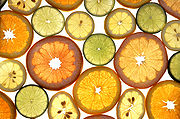
Nucellar embryony
Encyclopedia

Seed
A seed is a small embryonic plant enclosed in a covering called the seed coat, usually with some stored food. It is the product of the ripened ovule of gymnosperm and angiosperm plants which occurs after fertilization and some growth within the mother plant...
reproduction that occurs in certain plant species, including many citrus
Citrus
Citrus is a common term and genus of flowering plants in the rue family, Rutaceae. Citrus is believed to have originated in the part of Southeast Asia bordered by Northeastern India, Myanmar and the Yunnan province of China...
varieties. During the development of seeds from plants that possess this genetic trait
Trait (biology)
A trait is a distinct variant of a phenotypic character of an organism that may be inherited, environmentally determined or be a combination of the two...
, the nucellar tissue which surrounds the megagametophyte can produce additional embryos (polyembryony
Polyembryony
Polyembryony is the phenomenon of two or more embryos developing from a single fertilized egg . Polyembryony occurs regularly in many plants and animals. The nine banded armadillo, for instance, usually gives birth to four identical young...
) which are genetically identical to the parent plant. These nucellar seedlings are essentially clone
Cloning
Cloning in biology is the process of producing similar populations of genetically identical individuals that occurs in nature when organisms such as bacteria, insects or plants reproduce asexually. Cloning in biotechnology refers to processes used to create copies of DNA fragments , cells , or...
s of the parent. By contrast, zygotic
Zygote
A zygote , or zygocyte, is the initial cell formed when two gamete cells are joined by means of sexual reproduction. In multicellular organisms, it is the earliest developmental stage of the embryo...
seedlings are sexually produced and inherit genetic material
DNA
Deoxyribonucleic acid is a nucleic acid that contains the genetic instructions used in the development and functioning of all known living organisms . The DNA segments that carry this genetic information are called genes, but other DNA sequences have structural purposes, or are involved in...
from both parents.
Nucellar embryony is important to the citrus industry, as it allows for the production of uniform rootstock
Rootstock
A rootstock is a plant, and sometimes just the stump, which already has an established, healthy root system, used for grafting a cutting or budding from another plant. The tree part being grafted onto the rootstock is usually called the scion...
which yields consistent results in fruit production. However, this trait can interfere with progress in cross-breeding; most commercial scion
Grafting
Grafting is a horticultural technique whereby tissues from one plant are inserted into those of another so that the two sets of vascular tissues may join together. This vascular joining is called inosculation...
varieties produce mainly nucellar seedlings which do not inherit any of the traits of the "father" plant.

